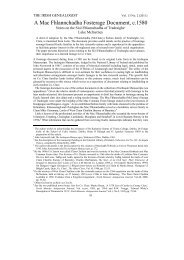Report Cover Vol I - Clare County Library
Report Cover Vol I - Clare County Library
Report Cover Vol I - Clare County Library
Create successful ePaper yourself
Turn your PDF publications into a flip-book with our unique Google optimized e-Paper software.
The <strong>County</strong> <strong>Clare</strong> Wetlands Survey Patrick Crushell & Peter Foss 2008<br />
____________________________________________________________________________________<br />
7.6 Damage to <strong>County</strong> <strong>Clare</strong> wetlands<br />
The majority of, if not all, Irish wetland sites have been subject to some degree of human damage or<br />
modification from their natural state in the past, and continue to be threatened by such activities.<br />
Wetlands, and bog, fen and marsh areas in particular have historically been regarded as less productive<br />
than adjacent agricultural land and measures have been taken to ‘improve’ their quality for agriculture.<br />
The principal method of land improvement has usually involved some form of drainage, burning clearance<br />
or addition of nutrients so as to facilitate the removal of peat, the planting of trees, or the creation of<br />
new grazing areas, pasture or farmland.<br />
In addition, a more recent trend has been the use of wetlands as areas to illegally dispose of rubbish and<br />
landfill materials.<br />
Reclamation and drainage works are an ongoing agricultural management tool which affect the<br />
hydrological condition of wetland habitats.<br />
During the course of the CWS, past and existing damage to wetlands were noted when these were<br />
reported in third party reports, surveys and data sources, and an overall assessment of the severity was<br />
undertaken where data was provided. The scale for the severity of damage used was: Not serious;<br />
Serious; Very Serious and Unknown.<br />
The damaging operation (based on the list of damaging operations recorded as part of the NHA surveys<br />
by NPWS (Lockhart et al. 1993), and the main habitats likely to be affected are detailed in Table 7.5<br />
below. This list of damaging operations on wetlands is by no means exhaustive (i.e. wind farm<br />
developments and their impact on upland bog and wet heath areas are not included) and might be<br />
expanded in the future should a detailed survey of damage to wetland sites be undertaken or based on<br />
the results of field surveys.<br />
Although insufficient time was available to undertake any detailed aerial photographic survey to record<br />
damage on sites recorded in the CWS, published reports indicate that 28 of the sites recorded in the CWS<br />
site database (see CWS Site Database on the report CD) were being damaged. It was clear from the GIS<br />
survey that extensive damage has been caused to the <strong>Clare</strong> wetland resource by past planting of conifers<br />
in upland bog areas, peat cutting throughout the bog areas and drainage activities across most wetland<br />
types.<br />
It is likely that the final number of sites being negatively affected by damaging activities will be much<br />
higher, as the 2008 NPWS report on the conservation status of EU Habitat Directive sites in Ireland<br />
(NPWS 2008), many of which are wetlands, found that the conservation status of these habitats is far<br />
from satisfactory. In fact the overall assessment for wetland habitat types listed under the EU Habitats<br />
Directive (see Appendix 6a) found that only 4 habitats were in favourable conservation status, while 7<br />
were poor and 16 habitat types were deemed to have a bad conservation status overall.<br />
Included in the latter bad conservation status category were priority habitats such as Lagoons,<br />
Calcareous springs, Raised bogs, Blanket bogs, Rich fens and Wet woodland; while habitats defined as<br />
poorly conserved included Dune slacks, Turloughs, Tall herb swamps, Marsh, Bog woodland and Scrub.<br />
These habitats account for a significant part of the wetland habitat resource in <strong>County</strong> <strong>Clare</strong>.<br />
65
















